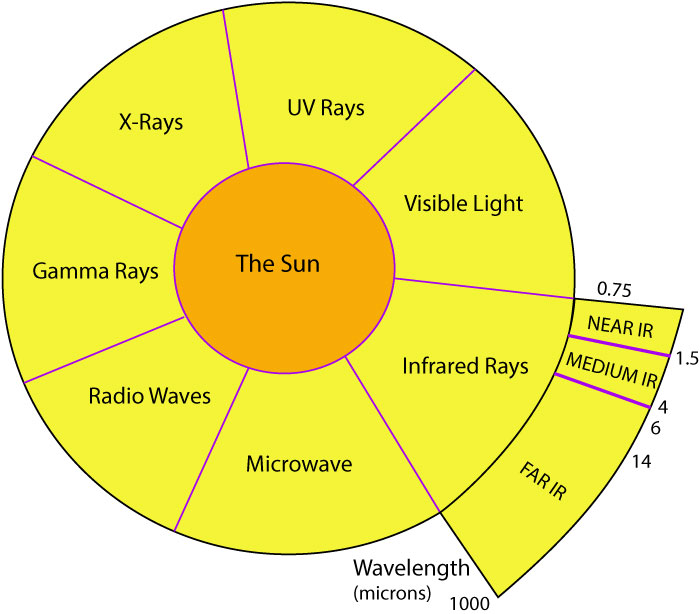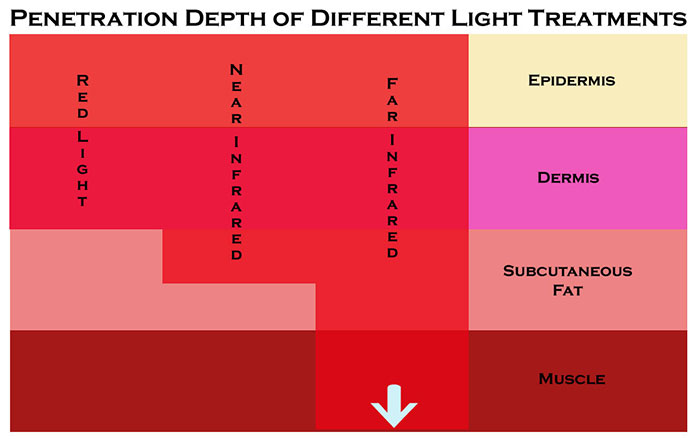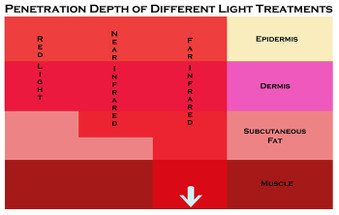Posted by BiomatStores.com on 7th Apr 2024
How Deep Does the Biomat Penetrate Compared to Other Light Therapies?
Imagine a world where healing is facilitated by the mere exposure to light. The use of light therapies, such as those offered by the Biomat, has been paving the way for non-invasive treatments. Understanding the fundamental differences between near infrared, far infrared, and red light is critical for discerning which therapy suits our needs.
Each type of light occupies a spot on the electromagnetic spectrum and interacts with our bodies in unique ways. Far infrared light warms deeply, near infrared light rejuvenates, and red light energizes at a cellular level. The depth at which these light waves penetrate the human body is a subject of both curiosity and clinical importance.
This article embarks on a journey through the nuances of light therapies, specifically comparing the penetration depth of the Richway Biomat's far infrared waves with other modalities. Whether you're considering light therapy or simply fascinated by its science, a clearer understanding awaits.
Understanding Near Infrared, Far Infrared, and Red Light
Near infrared (NIR), far infrared (FIR), and red light therapies are innovative forms of treatment that have gained significant recognition among health practitioners and scientific communities due to their numerous health benefits. These therapies are based on the use of specific wavelengths of light to penetrate the skin and underlying tissues, offering therapeutic effects.
The differentiating factor between these therapies lies in their wavelengths and how deeply they can penetrate into the human body. Far infrared rays, which can penetrate up to 16cm into the body's tissues and even more so when amplified (as they are in the Biomat which produces far infrared rays of up to 6-8 inches), leveraging the natural healing properties of amethyst crystals. This deep penetration may help improve blood circulation, provide pain relief, and promote relaxation of muscles through gentle warmth.
On the other hand, near infrared therapy has a different range of wavelengths, lying close to visible light on the electromagnetic spectrum, allowing for penetration that reaches just past the dermis and into the subcutaneous fat of the human body, with lasting effects on the cells it touches. Red light therapy operates at the edge of the visible light spectrum and it can penetrate just into the dermis, the layer just below the outer skin.
These light therapies are non-invasive, resulting in a beneficial experience that supports the body's natural healing processes at a cellular level. Their abilities to ease muscle spasms, relieve minor muscle pain, and aid in the relaxation of muscles are why devices like the Biomat have become valuable tools in both home and professional settings.

The Electromagnetic Spectrum Explained
The electromagnetic spectrum is a vast and variable range of different wavelengths and frequencies that include gamma rays, X-rays, UV rays, visible light, infrared light, microwaves, and radio waves. Gamma rays, X-rays, and UV rays possess shorter wavelengths that can be harmful to the human body with extended exposure. However, infrared light—including near infrared, far infrared, and red light—resides within a "safe zone" of the spectrum where it can be beneficial to the body without the detrimental effects associated with shorter wavelengths.
Far infrared rays, in particular, are known for their deep penetration into the human body, impacting blood vessels, organs, and even lymph glands. This infrared energy, while invisible to the eye, is gentle and safe, making it a stark contrast to the potentially dangerous gamma rays and X-rays. The use of FIR and NIR in medical devices provides a comfortable, non-destructive way of harnessing the healing power of light.
Far Infrared Light
Far infrared light (FIR) is renowned for its deep penetration into human tissues, making it an essential part of therapeutic treatments such as those afforded by the Biomat. The Biomat integrates the natural conductive properties of amethyst crystals to amplify the potency of FIR, allowing it to penetrate up to 6-8 inches into the body. This surpasses other FIR systems and provides substantive benefits at deeper levels than conventional heating pads or devices can reach.
Far infrared energy emission from the Biomat targets concentrations of heat between 6-14 microns, optimizing its therapeutic results. Embraced by the scientific community for its profound effects on cellular health, Biomat technology is backed by studies conducted by organizations like NASA and reinforcement from Nobel Prize-winning research. These sources endorse FIR's safety and value as a healing light wave that, when coupled with negative ions, can catalyze an in-depth healing process.
Near Infrared Light
Near infrared light (NIR) is a segment of the electromagnetic light spectrum adjacent to the visible light frequency, similar to that of natural sunlight. Its ability to penetrate up to 16cm into the tissues provides a long-term impact on cellular health. Specifically, NIR is praised for mimicking mitochondrial activity, boosting circulation, and facilitating detoxification in the skin—all crucial functions for maintaining skin's overall health.
The therapeutic use of NIR, akin to FIR treatments, penetrates deep within the dermis tissue and other body components, such as blood vessels, lymph glands, and nerves, providing comprehensive benefits. Its efficacious nature has led to widespread commendation from health experts across different fields for its healing properties and capabilities in improving various physical conditions.
Red Light
Red Light Therapy, also known as photobiomodulation, is a non-invasive treatment that uses red light to stimulate the body's natural healing processes. The light is typically delivered through LED or low-level laser lights. Red Light Therapy is believed to increase circulation, reduce inflammation, promote collagen production, and improve cellular function, leading to benefits such as reduced pain, improved skin health, and accelerated muscle recovery.
Red light is located in the visible spectrum of the electromagnetic spectrum, specifically towards the longer wavelength end. It has a wavelength of around 620-700 nanometers, falling just beyond the range of human vision. This particular range of red light is known to have therapeutic effects on the body, making it a popular choice for treatments like Red Light Therapy.

How Deep Each Light Wave Penetrates the Human Body
The human body is a complex organism that benefits from a wide range of therapeutic treatments, many of which involve light waves of varying frequencies and wavelengths. Understanding how deep each light wave penetrates the human body is key to optimizing these therapies for health and healing. We will explore the penetration depths of far infrared, near infrared, and red light waves, emphasizing their distinct therapeutic advantages when used in medical devices like the Biomat.
Far Infrared Penetration
The Biomat's use of far infrared (FIR) light is central to its effectiveness as a therapeutic device. Emitting rays that can reach up to 16cm (approximately 6-8 inches) into the body, FIR are the light waves with the longest wavelength. This deep penetration delivers benefits not only to surface muscles but to all cells, tissues, and vital organs beneath. The amethyst crystals used by the Biomat refract normal far infrared rays and make them 200x longer and stronger. This depth of penetration is significant when compared to near infrared and red light, which primarily affect the epidermis and dermis and are limited in their ability to impact deeper tissues.
Furthermore, the far-infrared heat generated from the Biomat is a gentle warmth that stimulates intense frictional heat by inciting cellular movement, reaching profound depths for substantial healing effects. Recognized by NASA, far infrared technology is lauded for its deep-penetrating effects that promote healing at a cellular level, aiding in processes This penetration allows the red light to stimulate cellular processes such as ATP production, collagen synthesis, and increased blood flow. These effects can help reduce inflammation, speed up healing processes, and alleviate pain in conditions such as arthritis, muscle injuries, and skin disorders. Overall, deep red light therapy offers a non-invasive and effective way to promote overall wellness and healing in the body.
Near Infrared and Red Light Penetration
Near infrared (NIR) light penetrates the epidermis and dermis and into the subcutaneous fat. It does not have the penetration depth of far infrared rays. NIR penetrates up to 50mm into the body.
Red Light penetration is about the same as NIR and can penetrate up to 1.9 inches into the human body.
All Light Therapies Have Their Time and Place
Far infrared therapy, also known as FIR therapy, uses wavelengths of light that penetrate deep into the body, reaching tissues, muscles, and organs. This type of therapy helps to increase circulation, reduce inflammation, improve detoxification, and promote overall relaxation and pain relief. Far infrared therapy is commonly used for conditions like arthritis, muscle pain, accelerating injury recovery, promoting detoxification, and improving immunity, sleep, and chronic fatigue.
Near infrared therapy, on the other hand, uses shorter wavelengths of light that can penetrate just below the skin surface. This type of therapy is beneficial for promoting wound healing, reducing inflammation, and increasing collagen production. Near infrared therapy is often used for skin rejuvenation, wound healing, and muscle recovery.
Red light therapy utilizes wavelengths of light that penetrate the skin to stimulate cellular energy production. This type of therapy is known to improve skin health, reduce inflammation, accelerate wound healing, and ease muscle and joint pain. Red light therapy is commonly used in skincare, pain management, and sports recovery.
In conclusion, while far infrared therapy is more penetrating and beneficial for deeper tissues, near infrared therapy and red light therapy are more focused on skin and superficial tissue benefits. Each form of light therapy offers unique advantages tailored to specific health concerns.


